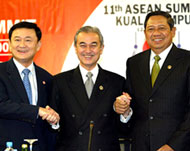Asean blog: Strength in numbers
The Asean summit has produced an unexpectedly strong statement regarding democracy in Myanmar.

It said “we encourage Myanmar to expedite the process”, and went on to recommend the “release of those placed under detention”.
Notably, there was no mention of the country’s pro-democracy leader Aung San Suu Kyi by name, but the intention of the statement was unmistakable.
The chairman of the Asean Standing Committee on Myanmar will visit the country, but so far there are no details about what his objectives will be, prompting sceptics to ask how the mission will be judged.
Just like so much of what Asean does, there are no clearly defined objectives or expectations, making it difficult for anyone to ascertain the relative successes or failures.
There is no question that Myanmar is the odd one out in the Asean forum. Most member states see it as the “black spot” on the history of the summit.
But clearly, engagement is the chosen tool for dealing with the apparent reticence of Myanmar’s military rulers in embracing democratic reforms.
Putin on hand
Tuesday sees the Asean member states hold a series of talks with each of the “plus three” members – Japan, China and South Korea, as well as the “plus one” states, Russia and India.
 |
|
Asean leaders discussed issues |
Perhaps most interesting is to consider the inclusion of Russia in the forum. Why is President Vladmir Putin starting to look towards Asia for trade and economic partnerships?
Is it because his failure to solve the problem of Chechnya is making it difficult for Russia to build stronger ties with Europe and the United States?
Most Eastern European states are enjoying their time in the spotlight as the new star performers on the continent, which begs the question: Why is Russia now looking to Asia?
East Asia summit
Wednesday sees the most anticipated of the talks at this year’s summit. The inaugural East Asia Summit includes all of the Asean member states, plus China, Japan, South Korea, Australia and New Zealand.
The EAS, as it is known, is seen as the possible foundation stone for a future free trading economic community in East Asia. Most of those involved believe any such agreement is at least one to two decades away.
Already, China and Japan are doing their best to develop leadership roles in the new forum by attempting to push talks in a variety of directions.
China clearly wants to focus almost exclusively on trade, while Japan is in favour of a broader approach to “community building”, which would not rely solely on a multilateral free trade agreement to see the East Asia summit eventually prove successful.
Non-Asian states
Also worth considering is the role of the non-Asian states, Australia and New Zealand. Asean is seen as a crucial piece of regional diplomatic architecture, particularly because it does not include the US.
 |
|
PM Abdullah (C): Strong ties with |
Critics of Australia’s inclusion in this year’s East Asia summit say Prime Minister John Howard will only be acting as a proxy for US interests in the region and therefore should not be involved.
The former Malaysian prime minister, Mahathir Mohamad, suggested as much last week.
New order
But his successor, Prime Minister Abdullah Ahmad Badawi, now more than two years into the job, is seriously asserting his own authority by stating clearly that there is a need for building strong ties between Asean with Australia and New Zealand.
It is important to remember too that Malaysia in particular played hard ball when it came to including Australia – forcing Canberra to sign the Treay of Amity and Cooperation (largely against its will), which would prevent Australia from intervening militarily in any Asean member states.
In the end, this year’s Asean summit will be judged primarily on whether the East Asia Summit, or the Asean plus three grouping emerges as the primary forum for trade negotiations in the future.
Either way, any regional free trading framework remains a long way off.